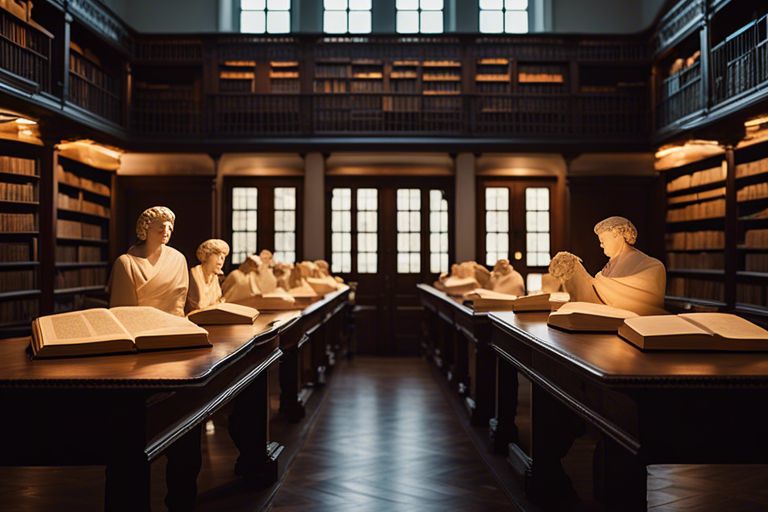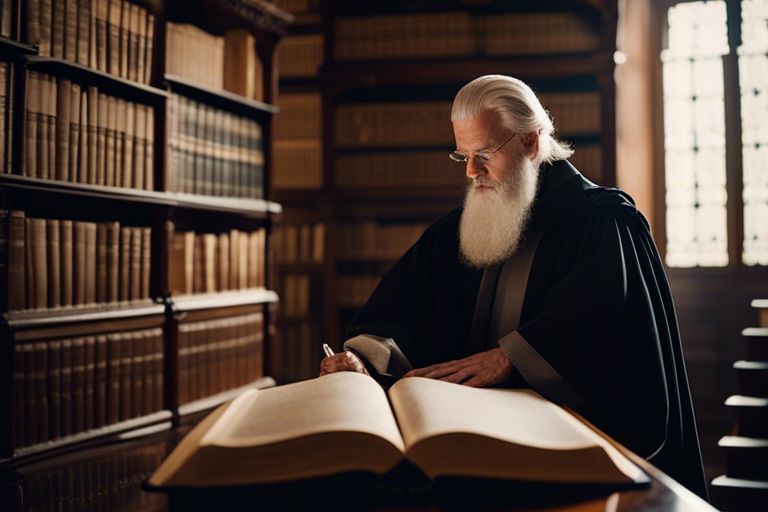You step into the world of the Masters of Art History (MA Art History), where each brushstroke tells a story, and every painting whispers secrets of the past. Delve into the enchanting realm of art and culture, unraveling the mysteries behind timeless masterpieces and discovering the profound impact of art on society throughout the ages. Join us on a journey through the corridors of history, where each canvas holds a fragment of humanity’s collective soul, waiting to be interpreted and understood.

Key Takeaways:
- Specialized Knowledge: A Master of Art History program provides students with a deep understanding of art history, allowing them to analyze, interpret, and critique various forms of art across different cultures and time periods.
- Research Skills: Students in this program develop advanced research skills that enable them to investigate and study art in scholarly and critical ways. These skills are important for writing thesis papers and conducting in-depth analyses of artworks.
- Career Opportunities: Graduates of MA Art History programs can pursue careers in museums, galleries, academia, publishing, and other art-related fields. This degree equips them with the knowledge and expertise needed to succeed in diverse art-related professions.
Defining Art History
The study of art history is a rich and complex field that investigates into the historical development and cultural significance of art across different societies and time periods. It seeks to understand the various contexts in which art was created and how it reflects and shapes human experiences and values.
Origins and Evolution
For centuries, art has been an integral part of human expression, serving as a medium to communicate ideas, emotions, and beliefs. The roots of art history can be traced back to ancient civilizations where art was closely tied to religious, political, and social functions. Over time, the discipline has evolved to encompass a wide range of artistic movements, styles, and mediums, reflecting the dynamic nature of human creativity.
Interdisciplinary Approaches
An interdisciplinary approach is crucial in the study of art history as it allows for a comprehensive understanding of art within the broader context of history, literature, philosophy, sociology, and anthropology. By drawing on insights from various disciplines, art historians can analyze artworks from multiple perspectives, shedding light on the intricate relationships between art and society.
To truly appreciate the depth and complexity of art history, students pursuing a Master of Art History degree are encouraged to explore interdisciplinary connections and engage in critical interpretations that transcend traditional disciplinary boundaries. This interdisciplinary approach not only enriches the study of art history but also fosters a more holistic understanding of the role of art in shaping human culture and identity.
Career Opportunities
One of the most appealing aspects of pursuing a Master of Art History degree is the wide array of career opportunities it opens up in the art world. Graduates can explore diverse paths, ranging from curatorial roles in museums to academic pursuits in research and teaching.
Curatorial Roles
One can find fulfilling careers as curators in prestigious museums and galleries around the world. Curators are responsible for managing collections, organizing exhibitions, conducting research, and engaging with the public to promote understanding and appreciation of art.
Academic Pursuits
Academic pursuits offer opportunities to research deep into art history through research, writing, and teaching. Many graduates go on to pursue doctoral degrees and become professors, sharing their passion for art history with the next generation of scholars.
Academic careers also allow art historians to contribute valuable insights to the field through publishing articles, presenting at conferences, and participating in collaborative research projects.
Art Conservation and Restoration
The field of art conservation and restoration is another avenue open to graduates of MA Art History programs. Conservationists work to preserve and restore artworks, ensuring their longevity and maintaining their integrity for future generations to appreciate.
Pursuits
The skills and knowledge gained through a Master of Art History program provide a solid foundation for a variety of career pursuits in the art world. Whether one’s passion lies in curating, academia, conservation, or other areas, an MA in Art History can pave the way for a fulfilling and meaningful career in the arts.
Course Structure and Curriculum
Core Modules
For those pursuing a Master of Art History (MA Art History) degree, the core modules form the foundation of the program. These modules typically cover areas such as art theory, art criticism, and research methods in art history. Students explore into the history of art movements, analyzing key artists, styles, and periods to gain a comprehensive understanding of the evolution of art throughout history.
Electives and Specializations
To enhance their learning experience, students are often given the opportunity to choose electives and specializations that align with their interests within the field of art history. Elective courses may focus on specific time periods, regions, or thematic approaches to art. Specializations allow students to concentrate their studies in areas such as Renaissance art, modern art, or contemporary art.
For instance, a student with a keen interest in Renaissance art may choose to specialize in this area, taking elective courses that explore deeper into the Italian Renaissance or the Northern Renaissance. By selecting electives and specializations that resonate with their passions, students can tailor their MA Art History degree to align with their career goals and academic pursuits.
Research and Thesis Components
To culminate their MA Art History journey, students often engage in research projects and complete a thesis under the guidance of faculty members. The research component allows students to apply their knowledge and skills in a substantial project that contributes to the field. Writing a thesis provides students with the opportunity to explore a specific topic in-depth, demonstrating their understanding of art history concepts and research methodologies.
To showcase their mastery of the subject, students are typically required to defend their thesis in front of a panel of experts, demonstrating their ability to critically analyze and interpret art historical material. This component of the program encourages students to develop their research and writing abilities while making a valuable contribution to the field of art history.
Skills and Knowledge Acquisition
Despite the diverse array of topics covered in a Master of Art History program, there are several key skills and bodies of knowledge that students acquire during their studies. These skills are vital for a successful career in the field of art history and the broader arts and humanities sector.
Critical Thinking and Analysis
Critical thinking and analysis are at the core of an MA in Art History. Students develop the ability to systematically evaluate and interpret artworks, texts, and primary sources. They learn to ask probing questions, challenge assumptions, and construct well-reasoned arguments based on evidence.
Historical Contextualization
Critical historical contextualization is another key skill developed in an MA Art History program. Students learn to situate artworks within their historical, social, political, and cultural contexts. This contextualization enables a deeper understanding of the forces and influences that shape artistic production.
Historical contextualization involves researching and analyzing the environments in which artworks were created. Understanding the historical context allows art historians to uncover layers of meaning and significance within the artwork that may not be immediately apparent.
Visual Literacy and Aesthetics
Historical visual literacy and aesthetics are also important components of an MA Art History program. Students learn to analyze and interpret visual elements such as composition, color, form, and style. They also develop an understanding of aesthetic theories and movements, gaining insight into the principles that underlie artistic creation.
Being visually literate and knowledgeable about aesthetics allows art historians to engage in nuanced discussions about art, offering informed interpretations and evaluations that contribute to the field’s ongoing dialogue and scholarship.

Top Universities for MA Art History Programs
Now let us probe into some of the top universities offering renowned MA Art History programs around the globe.
Global Rankings and Accolades
Universities offering MA Art History programs often rank highly in global university rankings. Institutions such as Oxford University, the University of Cambridge, and the Courtauld Institute of Art in London are recognized for their exceptional Art History departments. These universities not only provide students with a strong academic foundation but also offer access to world-class art collections and exhibitions.
Program Features and Faculty Expertise
Accolades aside, MA Art History programs are characterized by their diverse curriculum, covering various art movements, genres, and cultural contexts. The faculty members are experts in their fields, with many renowned scholars and curators leading courses and providing mentorship to students. This allows MA Art History candidates to gain valuable insights and guidance from professionals actively engaged in the art world.
The faculty members at these top universities often have extensive research experience and are actively involved in shaping the discourse around art history. Their networks and connections within the art community provide students with unique opportunities for internships, research projects, and collaborations, enriching their academic experience.
Application and Admission Requirements
Academic Background and Prerequisites
Prerequisites for the Master of Art History program typically include a bachelor’s degree in art history or a related field. Some programs may also consider applicants with a degree in a different discipline if they have taken relevant coursework or demonstrated a strong interest in art history.
Portfolio and Writing Samples
To apply for an MA in Art History, candidates are usually required to submit a portfolio of their academic work, including writing samples such as essays or research papers. This allows the admissions committee to assess the applicant’s critical thinking skills, writing ability, and potential for success in the program.
Applicants should carefully select their writing samples to showcase their analytical abilities and knowledge of art history. Including samples that demonstrate research skills and a deep understanding of art theory and historical context can greatly strengthen an application.
Interviews and Assessments
Interviews and assessments are often part of the admissions process for Master of Art History programs. These may include a phone or in-person interview, as well as writing assessments or subject-specific tests to evaluate the candidate’s knowledge and readiness for graduate-level study in art history.
During interviews, applicants may be asked about their academic interests, career goals, and reasons for pursuing a graduate degree in art history. Demonstrating a passion for the subject, a clear research agenda, and a strong motivation for further study can greatly enhance an applicant’s chances of admission.
Summing up
With these considerations in mind, pursuing a Master of Art History (MA Art History) is a profound journey that researchs into the depths of human creativity and expression. Through the study of artworks from various cultures and time periods, students can gain a deeper understanding of history, society, and the human experience. The analytical skills developed in this program not only enhance one’s appreciation for art but also provide a valuable foundation for a variety of career paths in the art world.
FAQ
Q: What is the Master of Art History program?
A: The Master of Art History program is a graduate degree that probes deep into the study of art and its historical context. Students examine various art movements, styles, and periods to develop a comprehensive understanding of artistic expression.
Q: What are the career opportunities for graduates of the MA Art History program?
A: Graduates of the MA Art History program often pursue careers in museums, art galleries, academia, and cultural institutions. Some become art critics, curators, educators, or researchers, while others work in art conservation or arts administration.
Q: What skills can students expect to develop in the Master of Art History program?
A: Students in the MA Art History program can expect to develop critical thinking skills, research abilities, visual analysis proficiency, and a deep understanding of art theory and history. They also hone their writing and communication skills, which are vital for a successful career in the art world.

